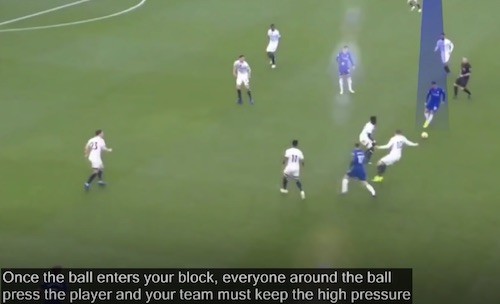| Defending from set-pieces is one of the most difficult jobs to get right when you’re playing soccer, especially given the different systems you can implement. As a soccer coach, do you have your team play zone or man mark? It’s a tough call but usually the best option is to do a combination of zonal marking and man marking, especially on corner kicks.
There are few more frustrating things for a soccer coach or manager than to concede a goal from a set-piece as it’s a clear indication that a system, or player, has failed in some way. If you watch Fox Soccer you’ll often hear Alexi Lalas talk about how much he loves set pieces and how often goals come from set pieces. Lalas often says the game is essentially about getting chances at goal from set pieces. To stop these set piece goals you have to have the right defense in place and be ready on corners, throw-ins, free kicks and any dead ball situation. Whether it’s man marking or zonal marking from set-pieces, there is always plenty of debate over which system is the best. Just as Celtic tend to lord it over their rivals in Scotland, the man-marking lobby used to be quick to shout down those in favor of zonal marking. There are two main types of marking; zonal and man. In this video, Alex Stewart & Joe Devine explain the differences between the two types of marking, and the different applications throughout the history of football and in the current game. But, gradually, zonal marking has come to be more appreciated and respected, and increasingly you’re finding that teams are using a mixture of the two systems. Here, we take a closer look at the two main ways you can defend at set-pieces. MAN MARKING In essence, man marking should be the most straightforward task to undertake as players have one simple instruction – stay tight and mark a specified opponent. It certainly allows a coach or manager to define prior to kick-off who will be responsible for marking which player, and it’s then easy to point out who was to blame if the system fails. It also ensures that defenders don’t have to worry about the complexities of a system as they know exactly what they are supposed to be doing when a corner or free-kick is taken. In theory, it should erase any need for doubt or confusion to arise. The problem with man marking is that it can actually be quite simple for opposition attackers to take advantage of. If the attacking team can bunch together, along with the defenders, then it makes it simpler for one of them to run around the back of the group. Their marker is then unable to track the run effectively and so the attacker has a free header or chance to score. ZONAL MARKING This system is favored by Rafa Benitez and he was heavily criticized every time Liverpool conceded a goal from a set-piece during his time as manager at Anfield. Yet the statistics actually showed Liverpool were extremely effective at playing a zonal marking system.
You can understand why people are quick to blame zonal marking for goals conceded from set-pieces. It points to a flaw in a system and therefore is the responsibility of the coach or the manager. Given the pressure the leading coaches and managers are under, it’s an easy stick with which to beat them with. Yet, implemented properly, zonal marking can make you much tighter defensively. The key to it is plenty of practice on the training ground and ensuring there is a good communication between players on the pitch. In the video below, I’ve tried to explain the meaning of zonal marking and listed kinds of other tactics that may be used while applying the zonal marking with examples to make the ideas more clear about this tactic which is used by many soccer teams around the world. While there may seem a more collective responsibility to making zonal marking work, there is just as much individual responsibility as man marking as a player must ensure he is in control of his zone. The key is not being attracted by the ball going into a different zone. But, like many things in soccer, it’s about finding a balance and that comes from using both systems. Having zonal marking along the six-yard box allows you to fully protect that zone and then man-marking the opponents’ best headers of the ball towards the edge of the penalty area is arguably the best of both worlds. One other thing to always consider, though, as former England coach Graham Taylor points out, is that you should have men defending the two posts to reduce the size of the goal as well, just in case your defensive set-piece system malfunctions. Extra: Sometimes even have plays where they set pics on defenders and block them from following their man. Teams try to be subtle about this and not get caught by the ref, but many times a player will turn and stand in front of and block a defender so their teammate can get through to say the near post and head the ball home. Ideally, as a soccer team, you of course want to limit the number of corners and free kicks entirely. That’s easier said than done but that’s surely a wait to prevent a number of goal scoring chances and win more soccer games. |
Defending Set-Pieces: Man or Zonal Marking?
















